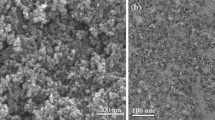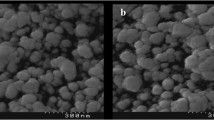Abstract
Because of their nanoporous structure and large surface area, carbon aerogels have high potential for improving the material properties of polymer-based composites. In the present study, the mechanical properties and toughness of epoxy polymers modified with an aerogel content of 0.0–0.5 wt% were considered. Experimental results showed that the stiffness and strength of the carbon aerogel toughened polymers steadily increased with the carbon aerogel content. The glass transition temperature of the unmodified epoxy polymer was 147 °C, and it was not appreciably affected by the addition of carbon aerogels. Blending the carbon aerogels with the epoxy polymer led to an appreciably improvement in the fracture performance of the resulting composites. For example, the fracture energy of the unmodified polymer was 125 J m−2, whereas that of an epoxy polymer reinforced with a carbon aerogel content of 0.3 wt% was 255 J m−2. The mechanisms responsible for the toughness enhancement were identified by studying the fracture surfaces using field emission gun scanning electron microscopy. Crack pinning, crack deflection, interfacial debonding, and plastic void growth were the main toughening mechanisms in the carbon aerogel toughened epoxy polymers.









Similar content being viewed by others
References
Ram A, Press Plenum (1997) Fundamentals of polymer engineering. Springer, New York
Kinloch AJ, Chapman and Hall (1987) Adhesion and Adhesives: Science and Technology, 1st edn. Chapman and Hall, London
Nicolais L, Guerra G, Migliaresi C, Nicodemo L, Di Benedetto AT (1981) Mechanical properties of glass-bead filled polystyrene composites. Composites 12:33–37
Lee J, Yee AF (2000) Fracture of glass bead/epoxy composites: on micro-mechanical deformations. Polymer 41:8363–8373
Kawaguchi T, Pearson R (2003) The effect of particle–matrix adhesion on the mechanical behavior of glass filled epoxies. Part 2. A study on fracture toughness. Polymer 44:4239–4247
Johnsen BB, Kinloch AJ, Taylor AC (2005) Toughness of syndiotactic polystyrene/epoxy polymer blends: microstructure and toughening mechanisms. Polymer 46:7352–7369
Kinlcoh AJ, Taylor AC (2006) The mechanical properties and fracture behaviour of epoxy-inorganic micro- and nano-composites. J Mater Sci 41:3271–3297. doi:10.1007/s10853-005-5472-0
Hsieh TH, Kinloch AJ, Masania K, Taylor AC, Sprenger S (2010) The mechanisms and mechanics of the toughening of epoxy polymers modified with silica nanoparticles. Polymer 51:6284–6294
Hsieh TH, Kinloch AJ, Taylor AC, Sprenger S (2011) The effect of silica nanoparticles and carbon nanotubes on the toughness of a thermosetting epoxy polymer. J Appl Polym Sci 119:2135–2142
Conradi M, Zorko M, Kocijan A, Verpoest I (2013) Mechanical Properties of epoxy composites reinforced with a low volume fraction of nanosilica fillers. Mater Chem Phys 137:910–915
Ho MW, Lam CK, Lau KT, Ng DHL, Hui D (2006) Mechanical properties of epoxy-based composites using nanoclays. Compos Struct 75:415–421
Ferreira JAM, Reis PNB, Costa JDM, Richardson BCH, Richardson MOW (2011) A study of the mechanical properties on polypropylene enhanced by surface treated nanoclays. Compos Part B-Eng 42:1366–1372
Shen MY, Chang TY, Hsieh TH, Li YL, Chiang CL, Yang H, Yip MC (2013) Mechanical Properties and tensile fatigue of graphene nanoplatelets reinforced polymers nanocomposites. J Nanomater 2013:1–9
Yeh MK, Tai NH, Liu JH (2003) Mechanical behavior of phenolic-based composites reinforced with multi-walled carbon nanotubes. Carbon 44:1–9
Yeh MK, Tai NH, Lin YJ (2008) Mechanical properties of phenolic-based nanocomposites reinforced by multi-walled carbon nanotubes and carbon fibers. Compos Part A-Appl Sci 39:677–684
Tai NH, Yeh MK, Peng TH (2008) Experimental study and theoretical analysis on the mechanical properties of SWNTs/phenolic composites. Compos Part B-Eng 39:926–932
Yeh MK, Hsieh TH, Tai NH (2008) Fabrication and mechanical properties of multi-walled carbon nanotubes/epoxy nanocomposites. Mater Sci Eng A-Struct 483–484:289–292
Hsieh TH, Kinloch AJ, Taylor AC, Kinloch IA (2011) The effect of carbon nanotubes on the fracture toughness and fatigue performance of a thermosetting epoxy polymer. J Mater Sci 46:7525–7535. doi:10.1007/s10853-011-5724-0
Bal S (2010) Experimental study of mechanical and electrical properties of carbon nanofiber/epoxy composites. Mater Des 31:2406–2413
Kinloch AJ, Mohammed RD, Taylor AC, Eger C, Sprenger S, Egan D (2005) The effect of silica nano particles and rubber particles on the toughness of multiphase thermosetting epoxy polymers. J Mater Sci 44:5083–5086. doi:10.1007/s10853-005-7261-1
Pekala RW (1989) Organic aerogels from the polycondensation of resorcinol with formaldehyde. J Mater Sci 24:3221–3227. doi:10.1007/BF01139044
Frackowiak E, Beguin F (2001) Carbon materials for the electrochemical storage of energy in capacitors. Carbon 39:937–950
Lee YJ, Park HW, Park S, Song IK (2012) Electrochemical properties of Mn-doped activated carbon aerogel as electrode material for supercapacitor. Curr Appl Phys 12:233–237
Li J, Wang X, Huang Q, Gamboa S, Sebastian PJ (2006) Studies on preparation and performances of carbon aerogel electrodes for the application of supercapacitor. J Power Sources 158:787–788
Qin CL, Lu X, Yin GP, Bai XD, Jin Z (2009) Activated nitrogen-enriched carbon/carbon aerogel nanocomposites for supercapacitor applications. T Nonferr Mater Soc 19:738–742
Mirzaeian M, Hall PJ (2009) Preparation of controlled porosity carbon aerogels for energy storage in rechargeable lithium oxygen batteries. Electrochim Acta 54:7444–7451
Jiang S, Zhang Z, Lai Y, Qu Y, Wang X, Li J (2014) Selenium encapsulated into 3D interconnected hierarchical porous carbon aerogels for lithium-selenium batteries with high rate performance and cycling stability. J Power Sources 267:394–404
Smirnova A, Dong X, Hara H, Vasiliev A, Sammes N (2005) Novel carbon aerogel-supported catalysts for PEM fuel cell application. Int J Hydrog Energy 30:149–157
Yang X, Sun Y, Shi D, Liu J (2011) Experimental investigation on mechanical properties of a fiber-reinforced silica aerogel composite. Mat Sci Eng A-Struct 528:4830–4836
ASTM-D638 (2010) Standard test method for tensile properties of plastics. ASTM, West Conshohocken
ASTM-D5045 (2007) Standard test method for plane-strain fracture toughness and strain-energy release rate of plastic materials. ASTM, West Conshohocken
ISO-13586 (2000) Plastics-determination of fracture toughness (G IC and K IC)-linear elastic fracture mechanics (LEFM) approach. ISO, Geneva
Andrews EH, Oliver and Boyd (1986) Fracture in polymer. Oliver and Boyd, London
Acknowledgements
The authors would like to thank the National Science Council, Taiwan, for financially supporting this research under a Contract No. NSC-102-2221-E-151-056.
Author information
Authors and Affiliations
Corresponding author
Rights and permissions
About this article
Cite this article
Hsieh, TH., Huang, YS. & Shen, MY. Mechanical properties and toughness of carbon aerogel/epoxy polymer composites. J Mater Sci 50, 3258–3266 (2015). https://doi.org/10.1007/s10853-015-8897-0
Received:
Accepted:
Published:
Issue Date:
DOI: https://doi.org/10.1007/s10853-015-8897-0




